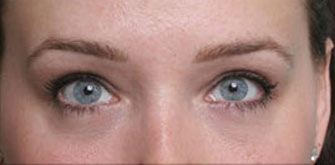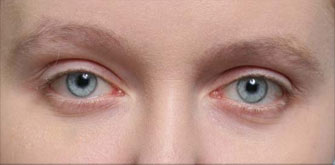Published on October 30, 2021 by Kenneth D. Steinsapir, M.D.
Upper eyelids actually only come in two types: an outie upper eyelid fold, and an innie upper eyelid fold. The implications of this division of upper eyelids are unavoidable and profound.
Innie and outie lids defined
First, formal terminology is helpful. Geologists study sedimentary rock and how these layers fold. Layers of sedimentary rock that make an upward fold are referred to as an antiform. Conversely, sedimentary rock that folds downward is called a synform. Analogically, we call eyelids that fold out an antiform eyelid. Similarly, eyelids that fold in, we call a synform eyelid.
The normal eyelid is the antiform fold or outie fold eyelid. Two fat volumes account for the fullness of the upper eyelid. When the eye is open, the orbital septum is relaxed and anterior orbital fat contributes volume to form the fold. Additional, volume is contributed to the upper eyelid fold from the fat pad that below the eyebrow.
In the normal eyelid, the anterior levator extends through Whitnall’s ligament to fan across the width of the upper eyelid platform to insert over the upper eyelid tarsus. The inelastic anterior orbital septum extends from the superior orbital rim just anterior to the anterior orbital fat to fuse with the levator aponeurosis at the level of the upper eyelid crease. Generally, this fusion occurs at or close to the superior edge of the tarsus in Caucasian eyelids and somewhat lower over the tarsus in Asian eyelids.

Outie Eyelid
In the synform fold, there is always an abnormal insertion of the anterior levator aponeurosis. The anterior levator is partially disinserted in these eyelids or completely disinserted. The partial disinsertion occurs in layers with the posterior capsule of the levator aponeurosis remaining intact in all but the most extreme cases.
Why is this important?
Central disinsertion of the levator allows retraction of the central levator aponeurosis into the orbit. It is also associated with retraction of the central anterior orbital fat reducing the volume of fat available to contribute to the upper eyelid fold. This loss of volume is exacerbated by upper eyelid ptosis associated with the levator disinsertion.
When there is sufficient upper eyelid ptosis, there will be a compensatory elevation of the eyebrow reducing the subbrow volume available to contribute to the upper eyelid fold. In many of these eyelids, there is also loss of the formal upper eyelid crease further contributing to a high, hollow sulcus.

Innie Eyelid
By understanding this anatomy, Dr. Steinsapir is in a position to discuss with you your options and preferences for eyelid surgery. This way you get what you want from upper blepharoplasty. This avoids surprise and disappointment from surgery when things turn out in a way other than what you expected. This is especially critical when trying to address prior, disappointing eyelid surgery.
Quality Time
Dr. Steinsapir spends quality time and listens to your concerns during his detailed personal consultations. That makes it much more likely you will get what you need from surgery. Many surgeons just don’t spend the time that is needed to get to the bottom of your concerns and properly explore the anatomic basis for those concerns.
Almost every patient is shocked by how detailed Dr. Steinsapir’s consultations are, but that is how he learns about your concerns and the basis for them. That can’t be accomplished during an online consultation. Your eyes can be your best feature.
About Dr. Steinsapir
Dr. Steinsapir is a board-certified eye surgeon and fellowship-trained in oculoplastic surgery and cosmetic surgery in Beverly Hills. He specializes in facial cosmetic surgery, repairing botched facial and eyelid cosmetic surgery, and botched facial fillers. He invented the Microdroplet Lift® a patented Botox method that naturally lifts the eyebrow without freezing the forehead. Dr. Steinsapir has a private practice and also serves as an Associate Clinical Professor of Ophthalmology at the Jules Stein Eye Institute, at the David Geffen School of Medicine at UCLA. Contact us today to learn how Dr. Steinsapir’s experience and training can make a real difference for you.
Services described may be “off-label” and lack FDA approval. This article is informational and does not constitute an advertisement for off-label treatment. No services should be provided without a good faith examination by a licensed physician and an informed consent with a discussion of risks, benefits, alternatives, and the likelihood of treatment success. Only you and your treating physician or surgeon can determine if a treatment is right for you.

